Henry Art Gallery - a great resource!
I want to tell you about an online resource I found via the internet. I was looking for a simple on-line stitch dictionary for my embroidery classes of students in grades 3, 4, 5 and 6 when I came across the Henry Art Gallery. It's at the University of Washington, in Seattle, WA, USA.
They have an extensive textile collection at the Henry Art Gallery. In addition, they have provided visitors to their web site with some wonderful resources.The introductory page looks like this. (See below) I did explore the "Costumes" and the "Connections" pages. They are interesting and I would recommend that you take time to look at them.
Naturally, I was most interested in the textile pages so I clicked on that first. The next page made me stop and think for a minute
about how I organize textiles in my mind. When I think about it, I put them into the following general categories: embroidered, knitted, carpets, woven, sewn. A bit of a mix and a muddle. The Henry Gallery has divided all textiles into two general groups: structure and embellishment. These two BIG categories allow for multiple and highly specific sub-categories.
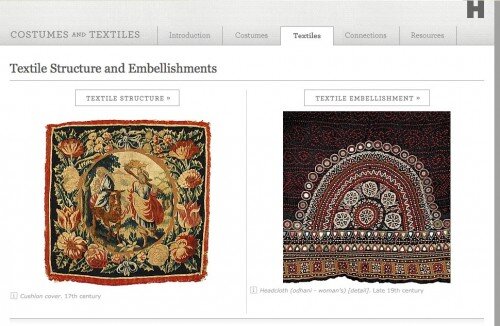 After I clicked on the "Embellishments" page, I discovered what their sub-categories were: applique, beaded, embroidered, painted, resist dyed, etc.. Wow! these are very, very specific!
After I clicked on the "Embellishments" page, I discovered what their sub-categories were: applique, beaded, embroidered, painted, resist dyed, etc.. Wow! these are very, very specific!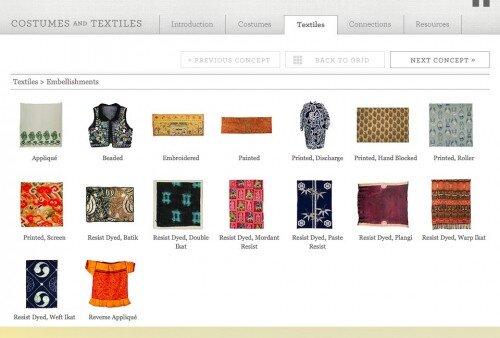 Clicking on "Embroidered" you will be taken to the embroidered home page. There you will find a brief description of embroidered embellishments. More importantly, on the bottom left side of the page, you will see a link that says "Visit our Embroidery Identification Stitch Guide".
Clicking on "Embroidered" you will be taken to the embroidered home page. There you will find a brief description of embroidered embellishments. More importantly, on the bottom left side of the page, you will see a link that says "Visit our Embroidery Identification Stitch Guide".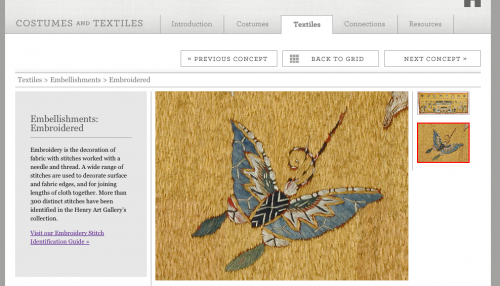 Click on the link entitled "Purpose" on the home page of the Embroidery Stitch Identification Guide and you will be taken to a page where you can search their textile collection by stitch! Do you want to see lots of pieces where stem stitch has been used? This is the place! "Acknowledgements" lists all the dedicated people who helped with this site and the Bibliography is a fantastic place to find books if you're building a library of embroidery books.
Click on the link entitled "Purpose" on the home page of the Embroidery Stitch Identification Guide and you will be taken to a page where you can search their textile collection by stitch! Do you want to see lots of pieces where stem stitch has been used? This is the place! "Acknowledgements" lists all the dedicated people who helped with this site and the Bibliography is a fantastic place to find books if you're building a library of embroidery books. The Embroidery Stitch Identification Guide is divided into 5 different areas, as you can see below; Stitches, Index, Stitch Classification, Usage and Glossary.The 'Stitches" section lists all the stitches in alphabetical order.
The Embroidery Stitch Identification Guide is divided into 5 different areas, as you can see below; Stitches, Index, Stitch Classification, Usage and Glossary.The 'Stitches" section lists all the stitches in alphabetical order.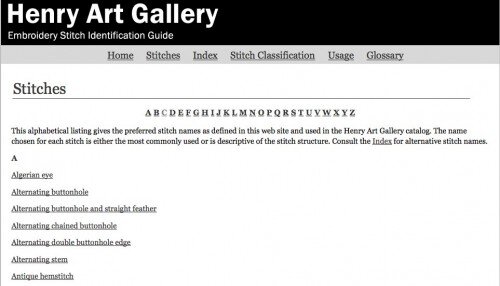 If you click on the name of the stitch, you will find yourself on a page with a photo of the stitch, structural usage, specific usage, additional names for the stitch, comments and a reference for where to find a diagram of the stitch. Some but not all of the stitches include diagrams of how to work the stitch. These are easy and clear to understand. Additionally there are Bibliographic Sources listed via another link. This is a great resource for books you might want to investigate further!
If you click on the name of the stitch, you will find yourself on a page with a photo of the stitch, structural usage, specific usage, additional names for the stitch, comments and a reference for where to find a diagram of the stitch. Some but not all of the stitches include diagrams of how to work the stitch. These are easy and clear to understand. Additionally there are Bibliographic Sources listed via another link. This is a great resource for books you might want to investigate further!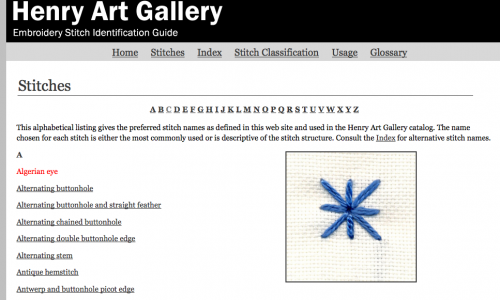 The pictures of the stitch pop up even if you don't open the linked page which is really useful if you're trying to find the name of a particular stitch you've seen. The index includes all the stitches with cross references.
The pictures of the stitch pop up even if you don't open the linked page which is really useful if you're trying to find the name of a particular stitch you've seen. The index includes all the stitches with cross references.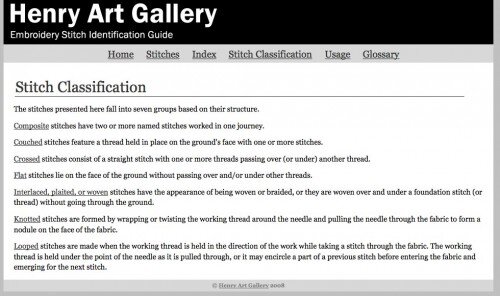 Under stitch classification you will find composite, couched, crossed, flat, interlaced, knotted and looped categories. I was most interested in the combination stitches and particularly liked the chained bullion knot.
Under stitch classification you will find composite, couched, crossed, flat, interlaced, knotted and looped categories. I was most interested in the combination stitches and particularly liked the chained bullion knot.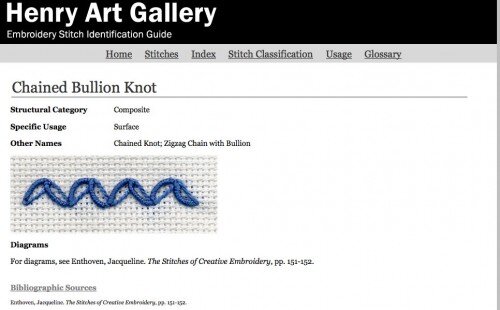 If you are planning which stitches to use in a piece you've designed, then the Usage page will be helpful. It's divided into edge, join and surface stitches.
If you are planning which stitches to use in a piece you've designed, then the Usage page will be helpful. It's divided into edge, join and surface stitches.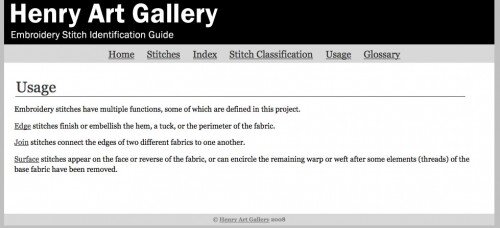 There is a glossary which would be helpful to someone new to embroidery when they are trying to understand our specific vocabulary.All in all, it's a site that's well worth spending time exploring."Visit our Embroidery Identification Stitch Guide".
There is a glossary which would be helpful to someone new to embroidery when they are trying to understand our specific vocabulary.All in all, it's a site that's well worth spending time exploring."Visit our Embroidery Identification Stitch Guide".
